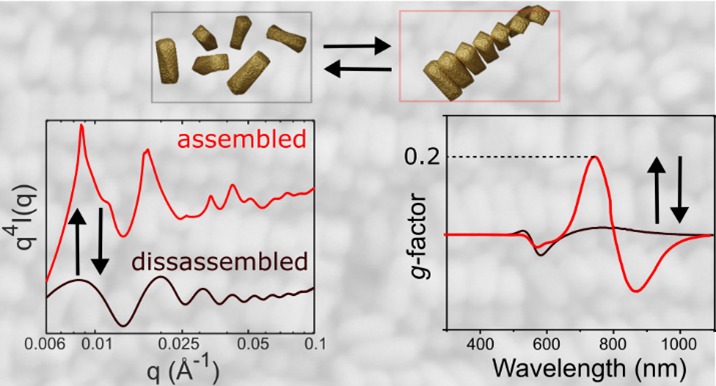Shaping Light with Reconfigurable Chiral Metafluids
 |
Researchers have developed a new way to dynamically control circularly polarized light by self-assembling chiral metallic nanoparticles. This result, at the crossroad between physics and chemistry, offers prospects for the synthesis of materials with new functional properties. At the nanoscale, controlling how light interacts with matter opens the door to technologies such as ultra-sensitive chemical sensors, polarization-based optical data storage, and even new catalysts. One powerful approach is plasmonic circular dichroism (PCD): the ability of tiny metallic structures to interact differently with left- and right-circularly polarized light. Two main strategies exist. One is to make nanoparticles that are themselves chiral so that each particle has its own built-in optical activity. The other is to take achiral particles and arrange them into chiral patterns. Both approaches work, but they have evolved largely separately. Only recently have scientists begun to combine them, aiming to create structures where intrinsic chirality and collective arrangement work together to boost optical responses. The challenge is that while researchers can create strong PCD signals, making them tunable and reversible in real time has proven far more difficult. In this work, we assembled fourfold twisted gold nanorods into higher order chiral architectures, amplifying the PCD response by more than two orders of magnitude compared to isolated nanorods. Using a technique called depletion-induced self-assembly (DISA), we exploit surfactant micelles to control how these twisted nanorods come together in solution. Nanoparticles can be assembled and dissassembled multiple times, allowing the chiral optical response to be switched on and off within the same sample. The PCD signal can reach high dissymmetry factors of around 0.2, while also shifting in wavelength in response to structural changes. This collaborative work between the Universities of Vigo and CIC Biomagune in Spain, the University of Antwerp (Belgium) and the University Paris-Saclay demonstrate that DISA offers a versatile route to build reconfigurable chiral nanostructures with tunable optical properties. The ability to reversibly control the structure and PCD response in liquid “metafluids” opens new opportunities for optical modulators and memory devices. While the current switching times of about one hour are too slow for display or computing technologies, this platform provides a new foundation for designing dynamic chiral materials that can actively manipulate the amplitude, frequency and polarization of light. This work has been published in Chemistry of Materials. Reference Tunable Plasmonic Circular Dichroism of Hierarchical Chiral Assemblies Jaime Gabriel Trazo, Andrés Serrano Freijeiro, Mikhail Mychinko, Nika Kutalia, Marianne Impéror-Clerc, Sara Bals, Luis M. Liz-Marzán, Jorge Pérez-Juste, Isabel Pastoriza-Santos, and Cyrille Hamon DOI : 10.1021/acs.chemmater.5c00909
|